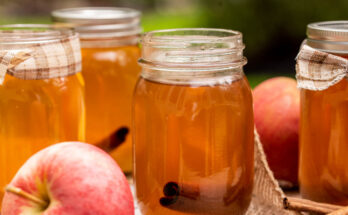Acorn Squash Soup Recipe: Imagine a bowl of warm, velvety soup cradled in your hands on a crisp fall evening. That’s what acorn squash soup delivers—a rich, comforting, and naturally sweet dish that warms you from the inside out. If you’ve never made it before, this is the perfect time to dive in. Whether you’re a soup lover or just exploring seasonal vegetables, acorn squash soup is the kind of recipe that tastes like autumn in a bowl.
This dish is packed with flavor, thanks to roasted squash and aromatic ingredients like garlic, onions, and a touch of spice. What’s more, it’s incredibly easy to customize—add a splash of cream for richness, coconut milk for a vegan twist, or top it with roasted pumpkin seeds for crunch.
Besides being insanely delicious, acorn squash is loaded with nutrients. It’s low in calories, high in antioxidants, and a fantastic source of vitamin C, potassium, and fiber. It’s the kind of meal that leaves you satisfied without feeling heavy. Plus, it stores well, so you can enjoy leftovers for days.
Ready to master this cozy favorite? Let’s get started by rounding up everything you’ll need.
List of Ingredients You’ll Need
Creating a silky, flavorful acorn squash soup starts with a few key ingredients. Here’s a detailed breakdown of what you’ll need for the base recipe, plus a few optional add-ins to take it to the next level.
Fresh Ingredients:
- 1 medium acorn squash (about 2 to 2.5 pounds) – The star of the show. Roasting brings out its natural sweetness.
- 1 large yellow onion, chopped – Adds depth and savory notes.
- 3 garlic cloves, minced – Essential for that warm, aromatic flavor.
- 1 medium carrot, peeled and chopped – Adds natural sweetness and color.
- 1 stalk of celery, chopped – Balances out the sweetness with a subtle earthiness.
- 1 tbsp olive oil or butter – For sautéing the vegetables.
- 4 cups vegetable broth or chicken broth – Provides the soup base.
Pantry Staples:
- Salt and freshly ground black pepper, to taste – Enhances overall flavor.
- 1/2 tsp ground nutmeg – A cozy, warming spice that pairs beautifully with squash.
- 1/4 tsp ground cinnamon – Optional, but adds a gentle warmth.
- 1/2 tsp crushed red pepper flakes (optional) – For a kick of heat.
Optional Toppings and Variations:
- Heavy cream or coconut milk – For extra creaminess.
- Toasted pumpkin seeds (pepitas) – Adds a crunchy texture.
- Fresh thyme or parsley – Brightens up the final dish.
- A drizzle of maple syrup – Enhances the natural sweetness of the squash.
By preparing these ingredients ahead of time, you’ll streamline the cooking process and make sure you’re set up for soup success.
Essential Kitchen Tools
Before we dive into the cooking, let’s make sure your kitchen is equipped with the tools you’ll need. Trust me, having the right equipment makes this process way easier.
Must-Have Equipment:
- Sharp chef’s knife – Crucial for safely cutting through the tough skin of the acorn squash.
- Cutting board – Go for one with grip to prevent slipping.
- Baking sheet – For roasting the squash to bring out its flavor.
- Large soup pot or Dutch oven – You’ll need this to sauté and simmer the soup.
- Blender (countertop or immersion) – For creating that silky-smooth texture.
- Measuring cups and spoons – To ensure the right balance of ingredients.
- Wooden spoon or spatula – Great for stirring without scratching cookware.
Time-Saving Kitchen Gadgets (Optional but Helpful):
- Microwave – Can be used to soften squash slightly before cutting.
- Immersion blender – Speeds up blending and means fewer dishes.
- Soup ladle – Makes serving neat and easy.
Once everything’s prepped and ready, you’ll be shocked at how easy and enjoyable the actual cooking process is.
Choosing the Best Acorn Squash
Picking the right squash is half the battle. A good squash can make the difference between bland soup and a dish bursting with flavor.
How to Pick a Ripe Acorn Squash:
- Color: Look for dark green skin with a splash of orange. Avoid ones that are entirely yellow or too pale.
- Weight: It should feel heavy for its size—a sign it’s full of moisture.
- Skin: Firm and smooth, without soft spots or wrinkles.
- Stem: A dry, corky stem is a good sign it’s mature and ready to eat.
Storage Tips Before Cooking:
- Room Temperature: Store it in a cool, dry place—no need for refrigeration.
- Shelf Life: Whole squash can last up to 1 month if stored properly.
- Cut Squash: Once cut, wrap tightly and refrigerate. Use within 4–5 days.
Getting this step right sets you up for a deeply flavorful soup with minimal effort.
Prepping the Acorn Squash
Let’s be honest—cutting into an acorn squash isn’t the easiest task. But with the right technique, you can do it safely and efficiently.
How to Safely Cut Acorn Squash:
- Microwave first (optional) – Zap the squash for 2 minutes to soften slightly.
- Stabilize it – Place the squash on a cutting board, stem side down.
- Use a sharp chef’s knife – Carefully slice the squash in half lengthwise.
- Scoop out the seeds – Use a spoon to remove the stringy pulp and seeds.
Roasting vs Boiling: Which is Better?
- Roasting: Concentrates flavor, caramelizes the flesh, and brings out sweetness.
- Boiling: Faster, but can result in a more diluted taste.
Roasting wins, hands down. You’ll get deeper flavor and better texture.
Flavor Enhancements During Roasting:
- Brush with olive oil
- Sprinkle salt and pepper
- Add garlic cloves or herbs in the cavity
These little touches go a long way in building that rich, roasted flavor base your soup needs.
Step-by-Step Guide to Making Acorn Squash Soup
Now that your squash is roasted and your ingredients are ready, it’s time to bring everything together in a silky, delicious soup. This step-by-step guide will walk you through the entire process so you can cook with confidence, even if you’re new to homemade soups.
Step 1: Roast the Squash
Begin by cutting the acorn squash in half and scooping out the seeds. Drizzle the flesh with olive oil, sprinkle a little salt and pepper, and place it face down on a baking sheet. Roast at 400°F (200°C) for 35–40 minutes, or until soft and caramelized.
Step 2: Sauté Aromatics
In a large pot, heat some butter or olive oil. Add chopped onions and minced garlic, cooking until fragrant and golden. This builds the savory backbone of your soup.
Step 3: Blend the Ingredients
Scoop out the roasted squash flesh and add it to the pot. Pour in vegetable or chicken broth and blend until smooth using an immersion blender or countertop blender.
Step 4: Simmer to Perfection
Return the blended mixture to the pot and simmer gently for 10–15 minutes to allow the flavors to meld beautifully.
Step 5: Final Seasoning & Tasting
Finish by stirring in a splash of cream or coconut milk for richness. Adjust with salt, pepper, and a pinch of nutmeg. Taste, tweak, and serve warm—creamy, comforting, and perfect for cozy nights in.
Tips for Making the Soup Extra Creamy
There’s something about a creamy soup that just feels more indulgent and satisfying. Here’s how to make your acorn squash soup extra velvety without overloading on calories.
Creaminess Without Cream:
- Use roasted squash as your natural thickener.
- Blend thoroughly for a smooth finish—lumps kill the vibe.
- Add a splash of unsweetened almond milk or oat milk for a dairy-free option that still adds richness.
With Dairy Options:
- Stir in ½ cup of heavy cream or half-and-half just before serving.
- For extra indulgence, try cream cheese or sour cream blended into the soup.
Pro Tips:
- Always add cream or milk after the blending and simmering phase to avoid curdling.
- Don’t boil after adding cream—just warm it through gently.
Flavor Variations You Can Try
Once you master the base recipe, the possibilities are endless. Switch things up with these creative flavor twists.
Thai-Inspired Acorn Squash Soup:
- Add 1 tbsp red curry paste during the sauté step.
- Use coconut milk instead of cream.
- Garnish with lime juice, cilantro, and crushed peanuts.
Spicy Chipotle Version:
- Add 1 canned chipotle pepper in adobo sauce to the blender.
- Mix in smoked paprika for extra depth.
- Top with crumbled bacon and green onions.
Apple & Cinnamon Twist:
- Sauté 1 chopped apple with the onions.
- Add a dash more cinnamon and nutmeg.
- Finish with a swirl of maple syrup.
These variations let you tailor the soup to your cravings or impress your guests with something unexpected.
Serving Suggestions
Presentation matters. Here’s how to serve acorn squash soup like a pro.
Best Bread Pairings:
- Crusty sourdough slices
- Garlic toast
- Cheddar biscuits
- Rustic multigrain rolls
Garnish Ideas:
- Drizzle of cream or coconut milk
- Toasted pumpkin seeds (pepitas)
- Fresh thyme, rosemary, or parsley
- Crispy bacon bits
- A dash of smoked paprika or chili oil
Serve the soup in a deep bowl or even inside a small roasted squash for a festive touch.
How to Store and Reheat
Great news—this soup stores beautifully and tastes even better the next day.
Refrigeration:
- Let the soup cool completely before storing.
- Transfer to an airtight container.
- Keeps well in the fridge for up to 4–5 days.
Freezing:
- Portion soup into freezer-safe containers or bags.
- Label and date them.
- Freeze for up to 3 months.
- Thaw overnight in the fridge before reheating.
Reheating:
- Gently reheat on the stove over medium heat.
- Stir occasionally to prevent sticking.
- Add a splash of broth or water if it thickens too much.
This makes it ideal for meal prep or make-ahead dinners.
Making Acorn Squash Soup Ahead of Time
Planning ahead? This soup is perfect for prepping in batches.
Meal Prep Tips:
- Roast and scoop the squash ahead of time and store in the fridge.
- Chop the veggies and store them in an airtight container.
- Make the soup up to 3 days in advance, and simply reheat when ready to serve.
Avoid These Pitfalls:
- Don’t add cream or dairy until just before serving—it can separate if reheated multiple times.
- Avoid freezing garnishes; add those fresh.
Making it ahead doesn’t just save time—it actually deepens the flavor as it sits.
Nutrition Breakdown
Wondering how healthy this cozy bowl of soup really is? The answer might surprise you—in a good way. Acorn squash soup is not only delicious but also loaded with nutrients that make it a smart choice for a wholesome meal.
Calories and Macronutrients (per 1-cup serving, approx.):
| Nutrient | Amount |
|---|---|
| Calories | 120–180 kcal |
| Carbohydrates | 22–28 g |
| Protein | 2–4 g |
| Fat | 4–9 g |
| Fiber | 4–6 g |
| Sugar (natural) | 4–8 g |
Note: These values can vary depending on cream additions, broth choice, and toppings.
Vitamins and Minerals:
- Vitamin C – Boosts immunity and promotes glowing skin.
- Vitamin A (from beta-carotene) – Great for vision and skin health.
- Potassium – Helps regulate blood pressure.
- Magnesium – Supports nerve and muscle function.
- Fiber – Aids digestion and keeps you feeling full.
Great for Special Diets:
- Low-calorie & nutrient-dense: Perfect for weight-conscious eaters.
- High in antioxidants: Helps reduce inflammation.
- Heart-friendly: Thanks to its low saturated fat content and high fiber.
If you’re looking to eat clean or cut back on processed ingredients, this soup checks all the right boxes.
Mistakes to Avoid
Even the simplest recipes can go sideways if you’re not careful. Avoid these common pitfalls to make sure your acorn squash soup comes out flawless every time.
1. Not Roasting the Squash Long Enough
Roasting is essential for deep, rich flavor. Undercooked squash will make your soup bland and grainy. Make sure it’s golden and fork-tender before using.
2. Overcrowding the Pot
When sautéing onions, garlic, and other aromatics, give them room to breathe. Overcrowding leads to steaming instead of browning, which means less flavor.
3. Skipping the Taste Test
Don’t wait until the soup is done to adjust the seasoning. Taste it as you go and tweak the salt, pepper, or spices little by little.
4. Using Too Much Liquid Too Soon
If you add all your broth at once, you might end up with watery soup. Add it gradually and stop when you hit the consistency you like.
5. Overheating Cream or Coconut Milk
Adding cream too early or reheating at high temperatures can cause separation. Always stir in cream at the end and gently warm through.
Keep these tips in mind, and you’ll avoid those rookie mistakes that can ruin a good soup.
Acorn Squash Soup for Special Diets
One of the best things about acorn squash soup is how versatile it is. Whether you’re following a plant-based diet, avoiding gluten, or counting carbs, there’s a version for you.
Vegan Version:
- Use vegetable broth instead of chicken broth.
- Swap heavy cream for unsweetened coconut milk or cashew cream.
- Sauté vegetables in olive oil or avocado oil instead of butter.
Gluten-Free Friendly:
- Naturally gluten-free as long as your broth is certified gluten-free.
- Watch out for store-bought toppings like croutons or sauces.
Low-Carb or Keto-Friendly Tweaks:
- Skip the carrot and reduce the onion (both add natural sugars).
- Add more herbs and spices for flavor depth.
- Use bone broth for extra protein and nutrients.
With just a few adjustments, you can make this soup work for nearly any dietary preference.
FAQs about Acorn Squash Soup Recipe
1. Can I use frozen squash instead of fresh?
Absolutely! Frozen acorn squash works in a pinch. Just make sure it’s fully thawed and drained before using. It might not have the same roasted flavor, but it’ll still be delicious.
2. What can I substitute for heavy cream?
You can use coconut milk, oat milk, almond milk, or even plain Greek yogurt for a lighter option. Each one will bring a slightly different texture and flavor, so experiment to see what you like best.
3. Is this soup spicy?
Not unless you add spice! The base recipe is mild and naturally sweet. You can dial up the heat by adding red pepper flakes, cayenne, or chipotle.
4. Can I make this in a slow cooker?
Yes! Simply sauté the aromatics first, then add everything to your slow cooker (including raw or roasted squash). Cook on low for 6–8 hours or high for 3–4 hours, then blend.
5. How long does it last in the fridge?
Stored in an airtight container, this soup will keep for 4–5 days. The flavor actually improves over time, so leftovers are a treat!
Conclusion
And there you have it—a full guide to making the coziest, creamiest, and most flavorful acorn squash soup from scratch. Whether you’re curling up on a cold evening or hosting a fall dinner party, this soup will hit all the right notes. It’s nourishing, satisfying, and simple to make with ingredients you probably already have in your kitchen.
From the naturally sweet roasted squash to the savory aromatics, every spoonful is like a hug in a bowl. Plus, it’s adaptable—vegan, spicy, creamy, or Thai-style—this recipe is your canvas.
So go ahead, roast that squash, fire up the blender, and enjoy the warmth and comfort of homemade acorn squash soup. Trust me, once you make it, you’ll be adding it to your cold-weather recipe rotation every year.



